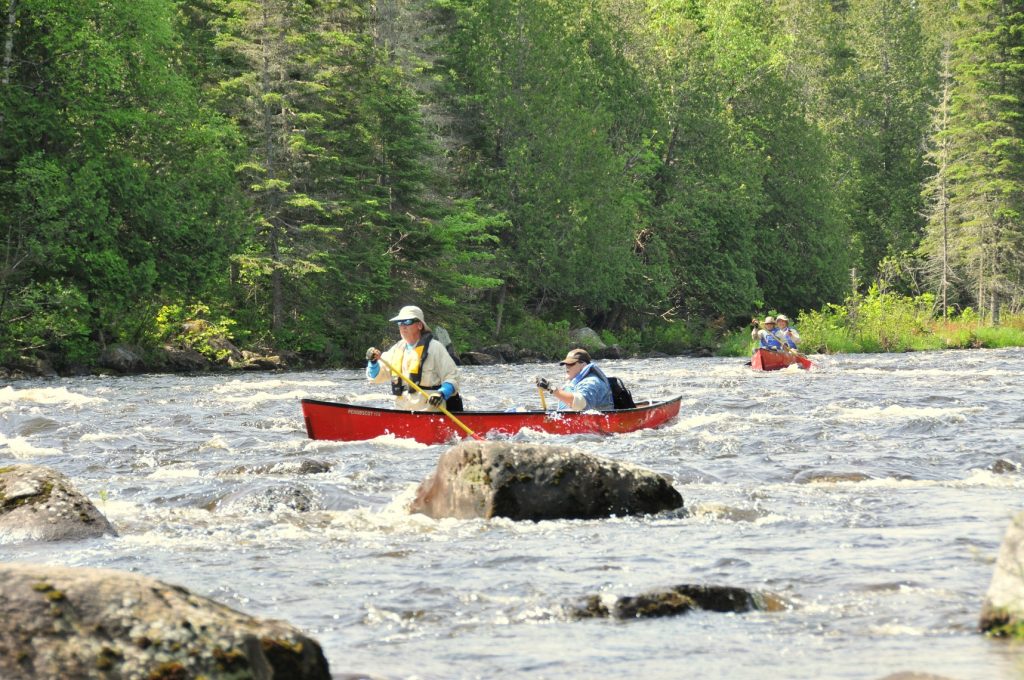Tips for Traveling the Allagash in Summer
 Canoeing and camping go together like bacon and eggs. The canoe can transport you to some of the most wild and pristine places in relative comfort. Unlike backpacking where weight is a primary concern, canoeing allows you can bring plenty of good food, roomy tents and other equipment necessary to make your camping adventure comfortable.
Canoeing and camping go together like bacon and eggs. The canoe can transport you to some of the most wild and pristine places in relative comfort. Unlike backpacking where weight is a primary concern, canoeing allows you can bring plenty of good food, roomy tents and other equipment necessary to make your camping adventure comfortable.
The Allagash Wilderness Waterway is the perfect place for canoe camping. Remote campsites are well maintained by rangers and waterway staff routinely patrol the area, giving visitors a sense of security. However, the waterway is 92 miles long and often the only other people seen on an Allagash canoe trip are at the primary access points. Readiness is one of the most important assets on any paddling adventure.
The key to an enjoyable canoe trip is planning. There are several resources available to help plan AWW adventures. Take advantage of the seven-part video series and Google Earth program, with pictures and descriptions of every campsite on the waterway available on the AWW website at: www.maine.gov/allagash. Also, The “Allagash Guide,” written by Gil Gilpatrick, is an awesome book that will help you plan a canoe trip to any remote waterway.
I’m often asked, “What size canoe do you recommend?” I prefer a large canoe, one that can carry gear without sitting too low in the water. I consider a 16-foot canoe to be the minimum size for an Allagash trip, but I highly recommend 17 to 18-foot canoes.
You will need some basic equipment for any river trip including: good fitting life jacket, quality tent, dry bags, cooking pans, sleeping bag and pad. The last time I went on a canoe trip I bought an L.L. Bean camp futon sleeping pad. I woke up every morning from a good night sleep ready to go! It remains one of the best pieces of camping equipment that I have ever purchased.
Food is a major component of any camping trip. I try to plan meals that can be cooked in one or two pans, because camp stove and fireplace space is limited and it saves time cleaning-up. On a canoe trip you can bring a cooler with meat, fresh vegetables, eggs and dairy products. You can also bring canned food for later in the trip, after the ice in the cooler has melted. One trick that I have learned is to freeze as much as possible ahead of time and keep these items in the cooler together- preferably in a cooler that doesn’t get opened very often.
The physical activity of paddling and outdoor living kindles a healthy appetite, so plan your meals accordingly. I always have an emergency meal planned in case an extra night is needed to complete the trip.
If you have never been canoe camping before I suggest going to a place near home first to figure out what you need to bring and what you can do without. A lot of people come to the waterway and stay at one campsite for a few days instead of traveling downstream each day. This would be a good way to work your way into wilderness canoe camping.
If all this planning and organizing seems too daunting, I suggest hiring a Maine Guide to lead the way. There are plenty of experienced guides that will take the anxiety out of an Allagash canoe trip.
Paddling a canoe requires physical strength and endurance, but it is also an art. There are nuances to be be learned from experienced paddlers. Techniques such as using the muscles in your torso instead of your arms. Also, feathering your paddle as you slide it along the gunwale as you bring the paddle forward. There is a great introduction to canoeing video online.
July is a great month for canoe camping. The water has started to warm up and is usually still at good level for canoeing, bugs have typically tapered off, and good weather is the norm.
The AWW is managed by the Maine Department of Agriculture, Conservation and Forestry’s Bureau of Parks and Lands as a wilderness canoe area. Great effort is made by managers of the waterway to ensure that visitors have a high-quality wilderness experience. Signs are kept to a minimum, access is restricted to certain locations and power equipment is not allowed on the AWW, unless specifically exempted by rule.
See AWW rules at: www.maine.gov/allagash for a complete list of waterway restrictions.
